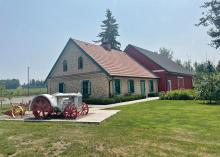A glimpse into how Mennonites lived and farmed a century ago awaits those who tour the recently opened housebarn at Mennonite Heritage Museum in Abbotsford, B.C. The design is a slightly scaled down replica of a housebarn owned by Mennonites in the Russian village of Neu-Osterwick near Zaporizhzhia.
According to museum executive director Richard Thiessen, the housebarn had been planned as stage two in the development of the museum, which opened in 2016. The pandemic delayed completion of the exhibit as travel restrictions prevented transportation of some artifacts from the U.S.
A ribbon cutting by local dignitaries formally opened the exhibit on April 1.
The housebarn, designed by Keystone Architects of Abbotsford, was modelled after photos taken by the late Victor Penner of a house built around 1898 in Chortitza, Ukraine. Some of the artifacts are genuine period antiques and some are replicas.
“We tried to look for furniture that dated from the late 19th century, either from Russia or from the Canadian prairies and the U.S. Midwest,” says Thiessen. Clothing in the wardrobe came from the 1983 Mennonite history documentary “And When They Shall Ask.”
The house part of the building is constructed of brick. A concrete floor represents what would have been a dirt floor. The front room, explains museum educator Jenny Bergen, was used for a sitting room by day and sleeping area at night. The fireplace/oven in the middle of the house was used for cooking and for heating the house. With space at a premium, all rooms and some furniture items were multifunctional.
The kitchen contains a set of dishes from Waltraut Bartel Cornelsen, who had hidden them under a woodpile on her parents’ property when fleeing Russia in 1942. Fifty years later, she returned to recover the dishes, still buried and in good condition.
“We had two goals with the housebarn,” says Thiessen. “First, it will show our museum visitors the kind of home that our ancestors owned in Ukraine and Russia. Those who came in the 1920s or after World War II would have lived in homes like our housebarn.”
Telling the Mennonite story through the lens of agriculture is the second component of the exhibit, explains Thiessen. “A significant part of the exhibit details the Mennonites’ contribution to the agricultural development of the Fraser Valley,” he says. “Themes in the exhibit include the impact that their environment had on Mennonites, their desire to transform their environment, their utilitarian approach to land, their willingness to move great distances to acquire land, and their role as settlers in Poland/Prussia, South Russia, and North and South America.”
The barn area is connected directly to the house, just as it would have been generations ago. This style of building was both economical and practical.
For more, see mennonitemuseum.org.





Comments
I'm glad that the housebarn includes on display a set of dishes that belonged to my dear, feisty aunt, Waltraut Bartel (nee Cornelsen).
However, the article incorrectly has her "fleeing Russia in 1942."
In fact, she belonged to those (many) Mennonites who never left West Prussia for Ukraine/Russia starting in the late 1700s. The dishes were buried on her family farm in the Vistula Delta in early 1945 in what was then part of Germany--about to be occupied by the Soviet army and eventually becoming part of Poland.
In 1984, Bartel and several younger family members retrieved the dishes in a risky adventure that has become part of our extended family's lore.
Add new comment
Canadian Mennonite invites comments and encourages constructive discussion about our content. Actual full names (first and last) are required. Comments are moderated and may be edited. They will not appear online until approved and will be posted during business hours. Some comments may be reproduced in print.